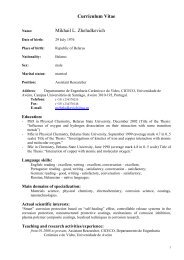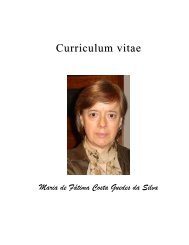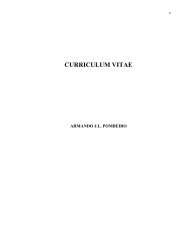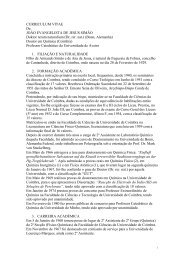XII Iberian Meeting of Electrochemistry XVI Meeting of the ...
XII Iberian Meeting of Electrochemistry XVI Meeting of the ...
XII Iberian Meeting of Electrochemistry XVI Meeting of the ...
You also want an ePaper? Increase the reach of your titles
YUMPU automatically turns print PDFs into web optimized ePapers that Google loves.
<strong>XII</strong> <strong>Iberian</strong> <strong>Meeting</strong> <strong>of</strong> <strong>Electrochemistry</strong> & <strong>XVI</strong> <strong>Meeting</strong> <strong>of</strong> <strong>the</strong> Portuguese Electrochemical Society O B 05<br />
Polymeric chemiresitive sensors for wood classification<br />
Renata Lippi, Jonas Gruber, Juliana R. Cordeiro, Erica S. Takahashi,<br />
Rosamaria W. C. Li<br />
Instituto de Química, Universidade de São Paulo, SP, Brasil<br />
Renata.Lippi@poli.usp.br<br />
An electronic nose [1] capable <strong>of</strong> identifying two pairs <strong>of</strong> wood species: (a) mahogany<br />
and cedar (Figure 1) and (b) Brazilian walnut and black-cinnamon was developed. The<br />
electronic nose consists <strong>of</strong> four gas sensors, fabricated by <strong>the</strong> deposition <strong>of</strong> thin doped<br />
conjugated polymer films onto <strong>the</strong> surface <strong>of</strong> interdigitated electrodes. The electrical<br />
conductance <strong>of</strong> <strong>the</strong>se electrodes was measured during exposure to <strong>the</strong> volatile<br />
compounds <strong>of</strong> wood samples. Treatment <strong>of</strong> <strong>the</strong>se data by principal component analysis<br />
and by cluster analysis gave excellent separation between <strong>the</strong> data sets. Leave-one-out<br />
analysis [2] presented a rate <strong>of</strong> hits <strong>of</strong> 100% in 80 identification assays carried out<br />
randomly with <strong>the</strong> above-cited species. Sets <strong>of</strong> electrodes have been tested for over six<br />
months and are still operational. The cost <strong>of</strong> each electrode is less than US$ 10. The<br />
equipment is portable and has low power consumption; hence, it can be used by police<br />
<strong>of</strong>ficers on <strong>the</strong> roads for <strong>the</strong> inspection <strong>of</strong> lorries carrying woods.<br />
Figure 1. PCA plot for mahogany and cedar<br />
Acknowledgments: to CNPq for <strong>the</strong> grants and financial support.<br />
References<br />
[1] Gardner, J. W.; Bartlett, P. N. Electronic Noses Principles and Applications, 1999, Oxford<br />
University Press. N.Y.<br />
[2] Lopes, F. M.; Martins-Jr, D. C.; Cesar-Jr, R. M. BMC Bioinformatics, 2008, 9, 451.<br />
September, 811, 2010. ISEL - Lisbon 38








